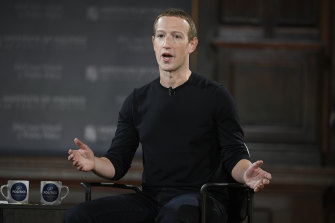With a global recession looming, the big US tech giants have been feeling the heat. Consumers tightening belts means less interest in gadgets and services, while businesses doing the same means a shrinking ad market. Then there’s the ongoing global chip shortage and slow recovery from a pandemic for the sector to contend with.
In May, the biggest tech companies had more than a trillion dollars wiped from their collective value in just three days. Apple, Microsoft, Alphabet and Amazon are the largest companies in the US, with their combined worth making up a quarter of the S&P 500 index, so all eyes were on them (and Facebook’s owner, Meta) this week as they posted their quarterly results.
Mark Zuckerberg’s Meta is in a transitional period as it moves from Facebook and Instagram to VR and the metaverse.
The overall theme seems to be that the challenges are more or less unprecedented, the market for both hardware and advertising is under a lot of pressure, and the relative strength of the US dollar doesn’t help when it comes to international business.
But the tech behemoths have largely been able to lean on the parts of their business that consumers truly find essential — the iPhone, Google’s search engine, Microsoft’s cloud services — to mitigate the worst of it. All except for Meta, which is struggling to hold on to whatever that essential element is.
Meta
The Facebook parent posted a 1 per cent year-on-year decline in revenue, its first ever, reporting $US28.8 billion ($41.1 billion) for the quarter versus $US29.08 billion last year. Profits were reported as $US6.7 billion, a 36 per cent fall.
The numbers indicate that Meta has run afoul not only of the decline in advertiser revenue (also affecting the likes of Google), but of some more specific issues as well.
A change to Apple’s iPhone software that lets users opt out of cross-app tracking has been disastrous for Facebook’s ad model, which along with Instagram’s has faced increased competition from the likes of TikTok eating into their monetisable users.
This all gives context for Meta’s recent changes to its social platforms that prioritise TikTok-style video recommendations rather than posts from friends. But these changes have attracted criticism from users, and the company has no clear plan to monetise the short-form videos. The big drop in profit could also be attributed to the company’s ongoing investments in futuristic technologies such as high fidelity VR and the metaverse.
Alphabet
Google parent Alphabet managed to avoid being as heavily impacted by dwindling ad money, posting revenue of $US69.7 billion, a 13 per cent year-on-year increase. Profit was down 14 per cent to $US16 billion.
Advertising growth was slow on YouTube, likely for the same reason it’s slow elsewhere; businesses around the globe are tightening their belts as the cost of everything increases. Ad revenue grew just 5 per cent over the quarter, compared with growing 84 per cent during the same period last year.
But ad spend on the Google search engine itself appeared much more resistant, growing 13 per cent to $US40.7 billion.
Apple
Apple’s revenue was up 2 per cent year-on-year at $US83 billion, with profit down 10 per cent to $19.4 billion; less of a fall than anticipated. But while the company sold more iPhones than expected, making up almost half of all revenue at $US40.7 billion, that still constitutes a significant slowing compared with years past.
Money from other products including Macs, AirPods and Apple Watches was all lower than expected and down year-on-year. The company’s services revenue grew, but not as much as in previous quarters. Apple chief executive Tim Cook told CNBC he expected revenue to accelerate in September despite “pockets of softness”.
Apple chief Tim Cook expects revenue to accelerate in September despite “pockets of softness”.Credit:AP
Apple has faced problems with manufacturing after pandemic-related shutdowns of China’s factories. But with so much of its revenue tied to selling new devices, there’s also concern that wider economic issues could obliterate demand.
Still, Apple chief financial officer Luca Maestri told Reuters there was no sign of a drop-off in demand ahead for iPhones.
Microsoft
Microsoft’s strongest sectors were, unsurprisingly, to do with productivity and web services. Revenue at its cloud businesses grew by 40 per cent, and Office consumer up 9 per cent year-on-year. LinkedIn was also strong, with revenue up 26 per cent this quarter off increased advertising demand. The company’s ad business on its search and news products were up 15 per cent year-on-year.
But other parts of the business were clearly affected by ongoing hardware shortages, including for computer chips. The revenue Microsoft makes from licensing Windows to new computers was down 2 per cent this quarter, as manufacturing continues to struggle. Hardware revenue from the company’s Xbox gaming division also fell 11 per cent, as it simply can’t make enough new consoles to satisfy demand.
Overall, the company reported revenue of $US51.9 billion (up 12 per cent) and a net income of $US16.7 billion (up 2 per cent).
Amazon
Amazon posted a revenue of $US121.2 billion, up from $US113.1 in the same period last year. But overall it lost $US2 billion, compared with a $US7.8 billion profit this time last year. It’s the company’s first quarterly loss since 2015, and largely informed by its $US3.9 billion write-down of the value of its stock investment in electric car start-up Rivian.
The company’s retail operations in the US and internationally reported operating losses, as costs rose and Amazon found itself with too many warehouses and employees relative to demand. But its AWS cloud business and ad sales picked up the slack, with 33 per cent and 18 per cent year-on-year jumps respectively.
Get news and reviews on technology, gadgets and gaming in our Technology newsletter every Friday. Sign up here.
Most Viewed in Technology
From our partners
Source: Read Full Article

